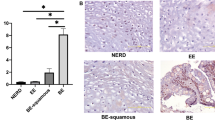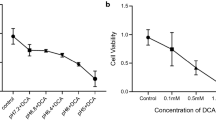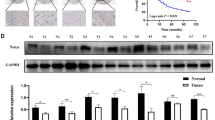Abstract
Vitamin A deficiency is associated with carcinogenesis, and upregulation of CYP26A1, a major retinoic acid (RA)-catabolizing enzyme, has recently been shown in cancer. We have previously demonstrated alterations of RA biosynthesis in Barrett's oesophagus, the precursor lesion to oesophageal adenocarcinoma. The aims of this study were to determine CYP26A1 expression levels and functional effects in Barrett's associated carcinogenesis. Retinoic acid response element reporter cells were used to determine RA levels in non-dysplastic and dysplastic Barrett's cell lines and endoscopic biopsies. CYP26A1 expression levels, with or without induction by RA and lithocholic acid, were determined by quantitative reverse transcriptase-PCR (RT–PCR) and immunohistochemistry. CYP26A1 promoter activity was determined by a luciferase reporter construct. CYP26A1 was stably overexpressed in GihTERT cells, which were evaluated for gene-expression changes (pathway array and quantitative RT–PCR), cellular proliferation (cytometric DNA profile and colorimetric assay) and invasion (in vitro matrigel assay) with or without the CYP inhibitor ketaconazole. RA levels decreased progressively with the degree of dysplasia (P<0.05) and were inversely correlated with CYP26A1 gene levels and activity (P<0.01). CYP26A1 expression was increased synergistically by RA and lithocholic acid (P<0.05). Overexpression of CYP26A1 led to induction of c-Myc, epidermal growth factor receptor and matrix metalloproteinase 3 as well as downregulation of tissue inhibitor metalloproteinase 1 and 3. Functional effects of CYP26A1 overexpression were increased proliferation (P<0.01) and invasion in vitro (P<0.01), which were inhibited by ketaconazole. Overexpression of CYP26A1 causes intracellular RA depletion and drives the cell into a highly proliferative and invasive state with induction of other known oncogenes.
This is a preview of subscription content, access via your institution
Access options
Subscribe to this journal
Receive 50 print issues and online access
$259.00 per year
only $5.18 per issue
Buy this article
- Purchase on Springer Link
- Instant access to full article PDF
Prices may be subject to local taxes which are calculated during checkout







Similar content being viewed by others
References
Abu-Abed SS, Beckett BR, Chiba H, Chithalen JV, Jones G, Metzger D et al. (1998). Mouse P450RAI (CYP26) expression and retinoic acid-inducible retinoic acid metabolism in F9 cells are regulated by retinoic acid receptor gamma and retinoid X receptor alpha. J Biol Chem 273: 2409–2415.
Avidan B, Sonnenberg A, Schnell TG, Chejfec G, Metz A, Sontag SJ . (2002). Hiatal hernia size, Barrett's length, and severity of acid reflux are all risk factors for esophageal adenocarcinoma. Am J Gastroenterol 97: 1930–1936.
Bax DA, Siersema PD, Van Vliet AH, Kuipers EJ, Kusters JG . (2005). Molecular alterations during development of esophageal adenocarcinoma. J Surg Oncol 92: 89–98.
Bertram JS . (1993). Inhibition of chemically induced neoplastic transformation by carotenoids. Mechanistic studies. Ann NY Acad Sci 686: 161–175; discussion 175–176.
Bigg HF, McLeod R, Waters JG, Cawston TE, Clark IM . (2000). Mechanisms of induction of human tissue inhibitor of metalloproteinases-1 (TIMP-1) gene expression by all-trans retinoic acid in combination with basic fibroblast growth factor. Eur J Biochem 267: 4150–4156.
Brabender J, Marjoram P, Salonga D, Metzger R, Schneider PM, Park JM et al. (2004). A multigene expression panel for the molecular diagnosis of Barrett's esophagus and Barrett's adenocarcinoma of the esophagus. Oncogene 23: 4780–4788.
Chang CL, Lao-Sirieix P, Save V, De La Cueva Mendez G, Laskey R, Fitzgerald RC . (2007). Retinoic acid-induced glandular differentiation of the oesophagus. Gut 56: 906–917.
Downie D, McFadyen MCE, Rooney PH, Cruickshank ME, Parkin DE, Miller ID et al. (2005). Profiling cytochrome P450 expression in ovarian cancer: identification of prognostic markers. Clin Cancer Res 11: 7369–7375.
Freemantle SJ, Spinella MJ, Dmitrovsky E . (2003). Retinoids in cancer therapy and chemoprevention: promise meets resistance. Oncogene 22: 7305–7315.
Group. MRCOCW (2002). Surgical resection with or without preoperative chemotherapy in oesophageal cancer: a randomised controlled trial. Lancet 359: 1727–1733.
Hormi-Carver K, Feagins LA, Spechler SJ, Souza RF . (2007). All trans-retinoic acid induces apoptosis via p38 and caspase pathways in metaplastic Barrett's cells. Am J Physiol Gastrointest Liver Physiol 292: G18–G27.
Klamt F, Dal-Pizzol F, Roehrs R, de Oliveira RB, Dalmolin R, Henriques JA et al. (2003). Genotoxicity, recombinogenicity and cellular preneoplastic transformation induced by vitamin A supplementation. Mutat Res 539: 117–125.
Liu T, Bohlken A, Kuljaca S, Lee M, Nguyen T, Smith S et al. (2005). The retinoid anticancer signal: mechanisms of target gene regulation. Br J Cancer 93: 310–318.
Lord RV, Tsai PI, Danenberg KD, Peters JH, Demeester TR, Tsao-Wei DD et al. (2001). Retinoic acid receptor-alpha messenger RNA expression is increased and retinoic acid receptor-gamma expression is decreased in Barrett's intestinal metaplasia, dysplasia, adenocarcinoma sequence. Surgery 129: 267–276.
Loudig O, Maclean GA, Dore NL, Luu L, Petkovich M . (2005). Transcriptional co-operativity between distant retinoic acid response elements in regulation of Cyp26A1 inducibility. Biochem J 392: 241–248.
Niederreither K, Abu-Abed S, Schuhbaur B, Petkovich M, Chambon P, Dolle P . (2002). Genetic evidence that oxidative derivatives of retinoic acid are not involved in retinoid signaling during mouse development. Nat Genet 31: 84–88.
Osanai M, Petkovich M . (2005). Expression of the retinoic acid-metabolizing enzyme CYP26A1 limits programmed cell death. Mol Pharmacol 67: 1808–1817.
Palanca-Wessels MC, Klingelhutz A, Reid BJ, Norwood TH, Opheim KE, Paulson TG et al. (2003). Extended lifespan of Barrett's esophagus epithelium transduced with the human telomerase catalytic subunit: a useful in vitro model. Carcinogenesis 24: 1183–1190.
Patel JB, Huynh CK, Handratta VD, Gediya LK, Brodie AM, Goloubeva OG et al. (2004). Novel retinoic acid metabolism blocking agents endowed with multiple biological activities are efficient growth inhibitors of human breast and prostate cancer cells in vitro and a human breast tumor xenograft in nude mice. J Med Chem 47: 6716–6729.
Pohl H, Welch HG . (2005). The role of overdiagnosis and reclassification in the marked increase of esophageal adenocarcinoma incidence. J Natl Cancer Inst 97: 142–146.
Radominska-Pandya A, Chen G . (2002). Photoaffinity labeling of human retinoid X receptor beta (RXRbeta) with 9-cis-retinoic acid: identification of phytanic acid, docosahexaenoic acid, and lithocholic acid as ligands for RXRbeta. Biochemistry 41: 4883–4890.
Reifen R, Nyska A, Koperstein L, Zusman I . (1998). Intestinal and hepatic cell kinetics and mucous changes in vitamin-A-deficient rats. Int J Mol Med 1: 579–582.
Saffiotti U, Montesano R, Sellakumar AR, Borg SA . (1967). Experimental cancer of the lung. Inhibition by vitamin A of the induction of tracheobronchial squamous metaplasia and squamous cell tumors. Cancer 20: 857–864.
Sah JF, Eckert RL, Chandraratna RA, Rorke EA . (2002). Retinoids suppress epidermal growth factor-associated cell proliferation by inhibiting epidermal growth factor receptor-dependent ERK1/2 activation. J Biol Chem 277: 9728–9735.
Schoenermark MP, Mitchell TI, Rutter JL, Reczek PR, Brinckerhoff CE . (1999). Retinoid-mediated suppression of tumor invasion and matrix metalloproteinase synthesis. Ann NY Acad Sci 878: 466–486.
Shelton DN, Sandoval IT, Eisinger A, Chidester S, Ratnayake A, Ireland CM et al. (2006). Up-regulation of CYP26A1 in adenomatous polyposis coli-deficient vertebrates via a WNT-dependent mechanism: implications for intestinal cell differentiation and colon tumor development. Cancer Res 66: 7571–7577.
Smith AH, Waller KD . (1991). Serum beta-carotene in persons with cancer and their immediate families. Am J Epidemiol 133: 661–671.
Van Heusden J, Van Ginckel R, Bruwiere H, Moelans P, Janssen B, Floren W et al. (2002). Inhibition of all-TRANS-retinoic acid metabolism by R116010 induces antitumour activity. Br J Cancer 86: 605–611.
Wald N, Idle M, Boreham J, Bailey A . (1980). Low serum-vitamin-A and subsequent risk of cancer. Preliminary results of a prospective study. Lancet 2: 813–815.
Webster RP, Gawde MD, Bhattacharya RK . (1996). Effect of different vitamin A status on carcinogen-induced DNA damage and repair enzymes in rats. In Vivo 10: 113–118.
Winters CJ, Spurling TJ, Chobanian SJ, Curtis DJ, Esposito RL, Hacker JF et al. (1987). Barrett's esophagus. A prevalent, occult complication of gastroesophageal reflux disease. Gastroenterology 92: 118–124.
Wolbach SB, Howe PR . (1925). Tissue changes following deprivation of fat-soluble A vitamin. J Exp Med 42: 753–777.
Wouters W, van Dun J, Dillen A, Coene M-C, Cools W, De Coster R . (1992). Effects of liarozole, a new antitumoral compound, on retinoic acid-induced inhibition of cell growth and on retinoic acid metabolism in MCF-7 human breast cancer cells. Cancer Res 52: 2841–2846.
Yung BY . (2004). c-Myc-mediated expression of nucleophosmin/B23 decreases during retinoic acid-induced differentiation of human leukemia HL-60 cells. FEBS Lett 578: 211–216.
Acknowledgements
We thank Guillermo De La Cueva Mendez for his help and advice and Madhumita Das for her help with the invasion assays.
Author information
Authors and Affiliations
Corresponding author
Rights and permissions
About this article
Cite this article
Chang, CL., Hong, E., Lao-Sirieix, P. et al. A novel role for the retinoic acid-catabolizing enzyme CYP26A1 in Barrett's associated adenocarcinoma. Oncogene 27, 2951–2960 (2008). https://doi.org/10.1038/sj.onc.1210969
Received:
Revised:
Accepted:
Published:
Issue Date:
DOI: https://doi.org/10.1038/sj.onc.1210969
Keywords
This article is cited by
-
Elevated expression of the retinoic acid-metabolizing enzyme CYP26C1 in primary breast carcinomas
Medical Molecular Morphology (2016)
-
Increased expression of the retinoic acid-metabolizing enzyme CYP26A1 during the progression of cervical squamous neoplasia and head and neck cancer
BMC Research Notes (2014)
-
Molecular Mechanisms of Barrett’s Esophagus
Digestive Diseases and Sciences (2011)
-
Enhanced expression of retinoic acid-metabolizing enzyme CYP26A1 in sunlight-damaged human skin
Medical Molecular Morphology (2011)
-
Oncogenic and cell survival properties of the retinoic acid metabolizing enzyme, CYP26A1
Oncogene (2010)



